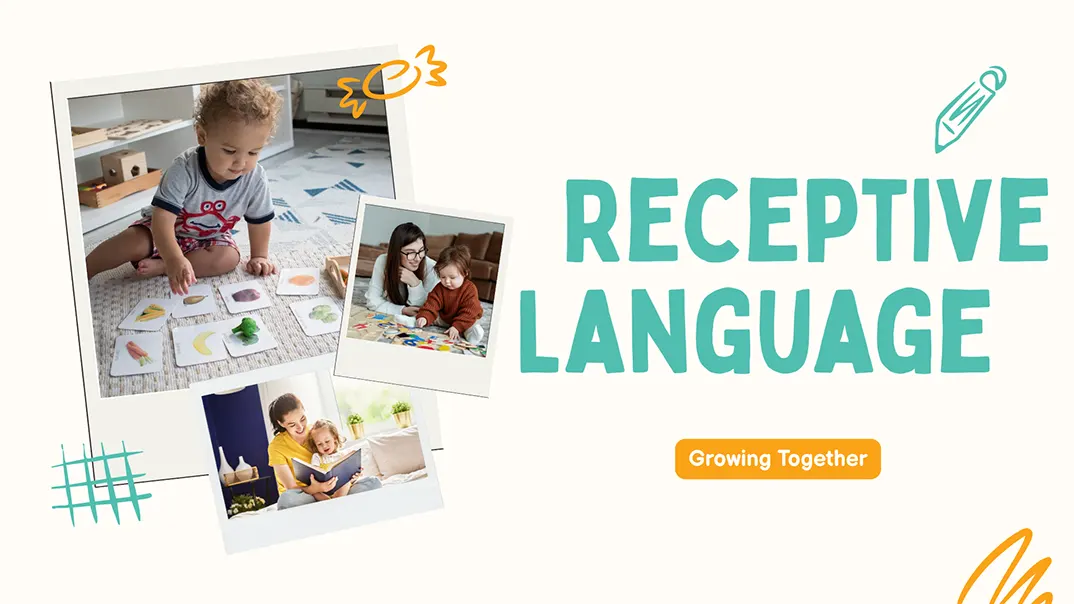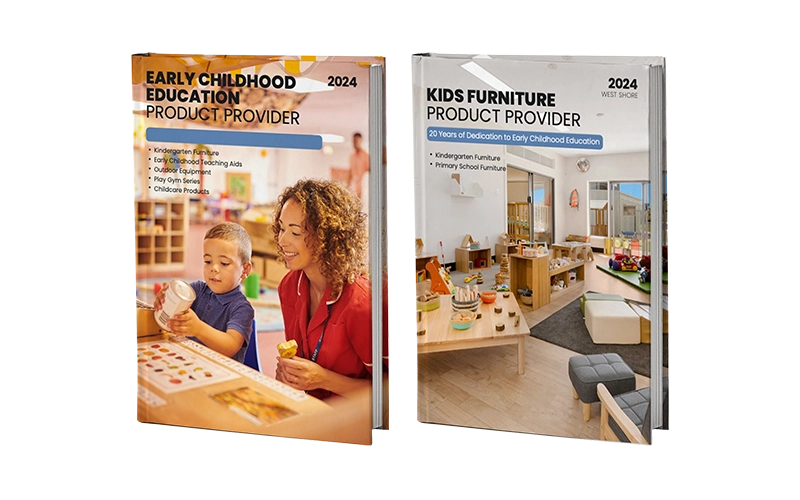Receptive language is the ability to understand and interpret the words, sentences, and meanings conveyed by others. It includes listening to spoken language, reading written language, and grasping non-verbal cues such as gestures and facial expressions. Unlike expressive language, which involves producing speech or writing to communicate thoughts, receptive language is all about comprehension.
This skill begins developing in infancy, long before a child can speak. For example, when a baby turns toward their name being called or reacts to familiar voices, they are already demonstrating early receptive language abilities. As children grow, their ability to process and understand language becomes more complex. They learn to follow directions, answer questions, and make sense of stories or conversations.
Receptive language relies on several components, including vocabulary knowledge, sentence structure awareness, and the ability to make inferences. It also depends on auditory memory and attention, as individuals must hear and retain information long enough to process it. For children alike, strong receptive language skills are crucial for academic success, social relationships, and daily functioning. Keep reading. Let’s take a closer look at receptive language, how it develops, and why it matters in a child’s growth.
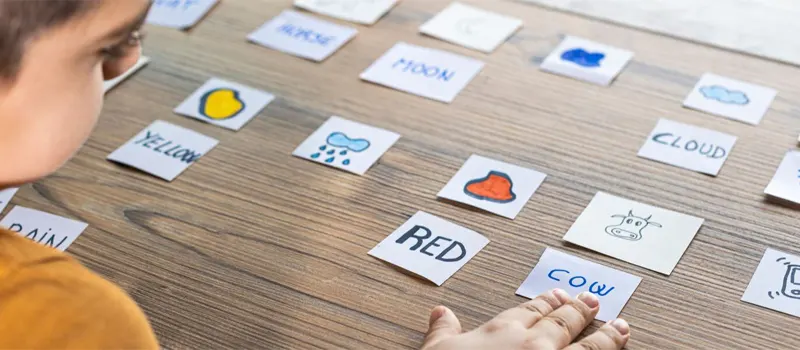
Why Is Receptive Language Important?
Receptive language helps young children understand the world around them. It allows them to follow directions, learn new words, and feel included in daily routines and social interactions. Before children can express themselves clearly, they need to understand what others are saying. This understanding supports learning, behavior, and communication from the very start.
Supports Academic Success
Receptive language plays a vital role in a child’s learning journey. It enables children to understand spoken instructions, classroom discussions, and lesson content. From listening to a story during circle time to following multi-step directions, these skills allow children to participate fully in academic activities. Children with strong receptive language are more likely to grasp new concepts, build vocabulary, and succeed in subjects that rely heavily on verbal input.
Strengthens Social Interaction
Understanding others is essential for forming friendships and engaging in group play. Receptive language helps children interpret what peers are saying, respond appropriately, and recognize social cues. It allows them to join conversations, take turns in games, and show empathy. When receptive skills are limited, children may appear withdrawn, confused, or uninterested, even though they want to connect. Strong receptive language supports confident and respectful social behavior.
Helps Regulate Behavior and Emotions
When children understand expectations and instructions, they feel more secure and are better able to manage their emotions. Receptive language helps them make sense of routines, transitions, and behavioral cues from adults. A child who cannot understand what is being said may become frustrated, anxious, or act out. Improving receptive language skills can reduce these emotional and behavioral difficulties, leading to a more positive learning and social environment.
Lays the Foundation for Expressive Communication
Before a child can speak fluently, they must first understand the words and structures they hear. Receptive language development comes before expressive language and provides the input children need to begin speaking. As children hear and comprehend more language, they gradually build the tools to express their own thoughts. A rich receptive vocabulary often leads to stronger and more accurate verbal expression.
Promotes Independence and Confidence
Children who understand language can follow daily routines, respond to questions, and solve problems with greater independence. Receptive language gives them the ability to act on their own, whether it involves getting ready for school or engaging in play without constant adult guidance. This sense of autonomy builds self-confidence and encourages children to take initiative in learning and interacting with the world around them.
What Skills Are Needed for Receptive Language Development?
Receptive language development relies on a combination of cognitive, auditory, and social-emotional abilities. These underlying skills form the foundation for understanding and processing language effectively. While receptive language is the overall process, receptive language skills are the specific tools the brain uses to make that process happen.

- Vocabulary comprehension: understanding the meaning of words and their use in different contexts.
- Auditory processing: recognizing, interpreting, and organizing sounds received through hearing.
- Attention and focus: maintaining concentration on spoken or written language long enough to process the information.
- Auditory memory: remembering spoken information such as instructions, questions, or stories for immediate or later use.
- Cognitive skills: using reasoning, problem-solving, and thinking abilities to make sense of language and draw conclusions.
- Grammar and syntax understanding: recognizing how word order and sentence structure affect meaning.
- Social-emotional awareness: interpreting non-verbal cues like tone, facial expressions, and body language to better understand intent and emotion in communication.
Examples of Receptive Language
Receptive language can be observed in many everyday moments where a child shows understanding through actions, gestures, or responses. These examples help highlight how children demonstrate comprehension, even before they speak fluently. Understanding these moments can help parents and educators identify how receptive language is developing and when support might be needed.
- Following directions: A toddler hears, “Go get your shoes,” and walks over to pick up their shoes.
- Responding to gestures: A child sees a caregiver point to the toy shelf and walks over to put a toy away.
- Recognizing facial expressions and tone: When a teacher speaks with a serious voice and a firm expression, the child stops what they’re doing and listens.
- Understanding written or visual symbols: A child sees the picture of a bed on a daily schedule and walks to the rest area for naptime.
- Following multi-step directions: A preschooler completes, “Put your cup on the table and wash your hands,” without needing the instruction repeated.
Prêt à concevoir un espace propice à l'apprentissage ? Contactez-nous pour créer des solutions de mobilier sur mesure, adaptées aux besoins de votre classe.
Stages of Receptive Language Development
Receptive language does not develop all at once. It follows a natural progression from birth through early childhood as the brain matures and the child is exposed to language in meaningful ways. Understanding these stages can help parents, caregivers, and educators recognize what to expect at each age and when to seek additional support.

0 to 12 Months – Begins Recognizing Voices and Tone
During the first year of life, babies begin laying the foundation for receptive language by tuning into familiar voices and the rhythm of speech. At this stage, babies notice changes in tone, respond to their name, and show recognition of simple, routine-based words. They begin to associate sounds with familiar people or objects, and they react with interest or comfort when caregivers speak to them. These early responses show that babies are already building the skills needed to understand language long before they can speak.
12 to 24 Months – Follows simple one-step commands
As receptive language develops in the toddler years, children start understanding a broader range of single words and simple instructions. They begin to follow common requests in daily routines and identify familiar people, objects, and actions. Toddlers also start responding to simple questions and enjoy naming or pointing to pictures when asked. This stage marks a rapid growth in comprehension as children begin connecting language with actions, choices, and everyday experiences.
2 to 3 Years – A Time of Rapid Receptive Vocabulary Growth
During this stage, children begin to understand longer sentences and more complex ideas. They can follow two-step instructions, interpret simple descriptions, and respond meaningfully to everyday questions. Their understanding of stories also grows as they begin to recognise characters, actions, and familiar events. Receptive language becomes more flexible and allows children to participate in conversations with greater accuracy and confidence.
3 to 4 Years – Expanding Comprehension of Structured Language
As children move into the preschool years, their receptive language becomes more sophisticated. They understand multi-step directions, make sense of why and how questions, and follow explanations that involve sequencing or simple reasoning. Children at this stage recognise spatial concepts such as in front of or behind, and can listen to longer conversations or stories without losing track of meaning. These skills help prepare them for group learning environments.
4 to 5 Years – Preparing for School-level Language Demands
By this age, receptive language supports more advanced learning and social interactions. Children understand detailed instructions during classroom activities and can follow group routines with minimal support. They answer questions about stories, recall key details, and begin making connections between different ideas. Their ability to understand language used for problem-solving also increases, helping them navigate early academic tasks and more complex social situations.
How to Develop Receptive Language Skills?
Receptive language skills can be nurtured through intentional communication, rich language exposure, and engaging interaction. Whether at home or in the classroom, small everyday efforts can lead to big improvements in how children understand and process language.

Talk with Children Frequently
The more language children hear, the more opportunities they have to build understanding. Use clear, simple sentences when speaking with young children. Describe what you are doing, name objects around them, and talk about daily routines. This ongoing exposure helps children connect words with actions, people, and experiences.
Read Together Daily
Reading aloud is one of the most powerful tools for building receptive language skills. Choose books with colorful pictures, repetitive phrases, and engaging stories. Pause to ask questions like “What do you think will happen next?” or “Where is the dog?” Encourage children to point, answer, or react to the story.
Use Visual Supports
Pairing spoken language with visual cues such as pictures, gestures, or real objects can help children understand meaning more easily. For example, showing a toothbrush when saying “It’s time to brush your teeth” reinforces comprehension. Visual schedules and picture cards are especially helpful for children with language delays.
Use Consistent Language During Routines
Routines are ideal for introducing and repeating familiar words. Use the same phrases for everyday tasks such as “Time to eat,” “Let’s wash hands,” or “Clean up, please.” Children begin to associate these words with specific actions and situations. Over time, they will respond to these routine phrases with little prompting.
Give Clear and Consistent Instructions
Use short, consistent phrases when giving directions. Start with one-step commands like “Get your shoes” and gradually move to two- or three-step instructions. Be patient, give children time to process, and repeat instructions if necessary using the same words.
Use Montessori Language Materials
Montessori language materials are designed to support receptive (and later expressive) language in a hands-on, engaging way.


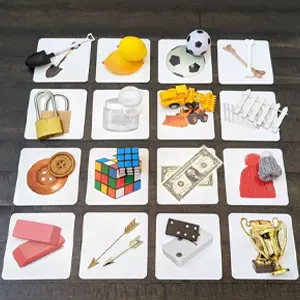
- Classified Cards (Nomenclature Cards)
These cards present vocabulary in categories such as animals, furniture, tools, or parts of the body. Children match picture to picture or picture to object while listening to the adult name each item. This supports word recognition and auditory association. - Three-Part Cards
Also known as control, picture, and label cards, this classic Montessori material encourages vocabulary development by helping children connect spoken, written, and visual forms of words. The adult may say the word while the child selects or matches the correct image. - Object-to-Image Matching
Children match real miniature objects (like a tiny apple or shoe) with corresponding cards. This tangible matching activity strengthens vocabulary and understanding through real-world associations.
Prêt à concevoir un espace propice à l'apprentissage ? Contactez-nous pour créer des solutions de mobilier sur mesure, adaptées aux besoins de votre classe.
Play Interactive Language Games
Children learn best when they are engaged, curious, and having fun. Interactive language activities provide opportunities for children to listen, respond, and process spoken information in meaningful ways. These games and routines can be used at home, in therapy, or in the classroom to strengthen comprehension skills through natural practice.
- Simon Says: This classic listening game encourages children to pay close attention to verbal directions. It supports understanding of action words and helps improve focus.
- I Spy: A fun way to practice vocabulary and listening comprehension. Use descriptive clues to help children identify objects in their environment.
- Picture Matching Games: Matching animals, foods, or objects with spoken prompts helps children build word-object associations and strengthen vocabulary understanding.
- Story Sequencing Cards: Ask children to arrange picture cards in the correct order after hearing a story. This supports memory, listening skills, and understanding of cause and effect.
- “Find It” Treasure Hunts: Give children simple clues like “Find something that is blue” or “Bring me something soft.” This promotes comprehension of adjectives and categories.
Ask Questions and Encourage Response
Even if children are not yet verbal, asking simple questions promotes language thinking. Give them choices such as “Do you want the apple or the banana?” or ask yes-or-no questions. Observe their gestures or expressions as signs of understanding, and respond warmly to reinforce communication.
Be Patient and Allow Time to Respond
Children often need extra time to process what they hear before they can respond. After giving a direction or asking a question, pause and wait. Avoid repeating too quickly or finishing the child’s response. When they do react, whether through action or words, acknowledge their effort and respond positively to reinforce learning.
Receptive Language vs Expressive Language
Receptive language and expressive language are two key components of communication that work together but serve different purposes. Receptive language is the ability to understand what others say or write, while expressive language is the ability to share thoughts, ideas, or feelings through speech, writing, or gestures.
In early childhood, receptive language typically develops before expressive language. For example, a toddler may understand the word “ball” and look at it when asked but might not yet be able to say the word themselves. Both types of language are essential for overall development, and strengthening one often supports the growth of the other.
| Aspect | Receptive Language | Expressive Language |
|---|---|---|
| Se concentrer | Understanding others | Communicating with others |
| Includes | Listening, reading, observing gestures | Speaking, writing, using gestures |
| Develops first | Yes | Usually develops later |
| Exemple | Following the instruction “Get your shoes” | Saying “I want my shoes” |
| Role in communication | Helps interpret messages | Helps share ideas and needs |
What Is Receptive Language Disorder?
Receptive language disorder is a condition where a child has difficulty understanding spoken or written language. This can affect their ability to follow directions, understand questions, or make sense of stories and conversations. Unlike children who are simply late talkers, those with receptive language disorder struggle with understanding language even when it is presented clearly and in familiar settings.
The disorder may occur on its own or alongside other conditions such as expressive language disorder, autism spectrum disorder, or developmental delays. Early identification is important, as targeted support can greatly improve outcomes for children experiencing these difficulties.
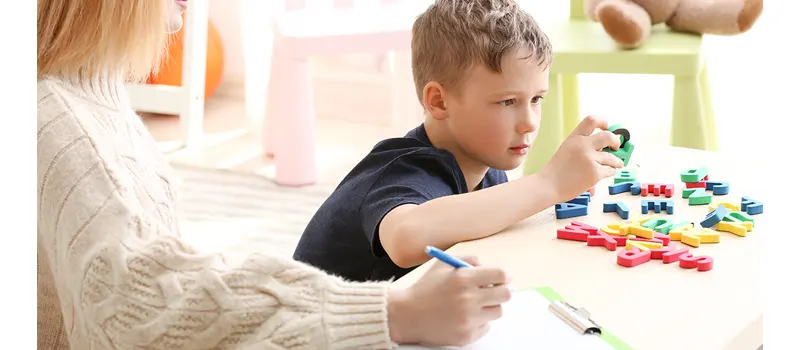
Signs of Receptive Language Disorder
- Difficulty following directions, especially if they involve more than one step
- Seeming to ignore when spoken to or frequently asking for repetition
- Trouble answering simple questions or giving unrelated responses
- Limited understanding of words, phrases, or stories
- Difficulty identifying familiar objects, pictures, or people when named
- Struggles with understanding classroom routines or peer interactions
- Seeming easily frustrated or withdrawn during group activities or conversations
When to Seek Help?
If a child consistently shows signs of receptive language difficulties beyond what is expected for their age, it is important to consult a speech-language pathologist or a pediatrician. Professionals can conduct a comprehensive language assessment to determine whether the child has a receptive language disorder and recommend strategies or therapy to support their development.
Early intervention can make a significant difference in helping the child understand language more effectively. Families and educators can also learn techniques to support comprehension at home or in the classroom. Trusting your observations and acting early is key to giving the child the best chance to succeed.
FAQ
Q1: At what age does receptive language develop?
Receptive language begins developing at birth. Infants recognize voices and tone early on, and by 6 to 12 months, most babies start understanding basic words and commands.
Q2: When should a child be able to follow simple instructions?
Most children can follow simple one-step instructions, such as “Come here,” by around 12 to 18 months. Two-step directions typically develop closer to age 2.
Q3: Should you target expressive or receptive language first?
Receptive language should be supported first. Understanding comes before speaking, so strengthening comprehension helps build a strong foundation for expressive skills.
Q4: How do I improve my child’s receptive language?
Talk to your child regularly, read aloud every day, play listening games, and give clear, simple directions. Consistent exposure and engagement are key to improvement.
Q5: What causes receptive language difficulties?
Receptive language challenges may result from developmental delays, hearing loss, neurological conditions, or limited language exposure during early years.
Conclusion
Receptive language is the foundation of a child’s ability to understand the world around them. From following directions to enjoying conversations and participating in learning, strong receptive language skills support success in every area of life. As we have seen, these skills begin developing in infancy and continue to grow through rich interactions, meaningful play, and consistent support.
Fostering receptive language is not just about building vocabulary; it is about giving children the tools they need to listen, understand, and thrive.

